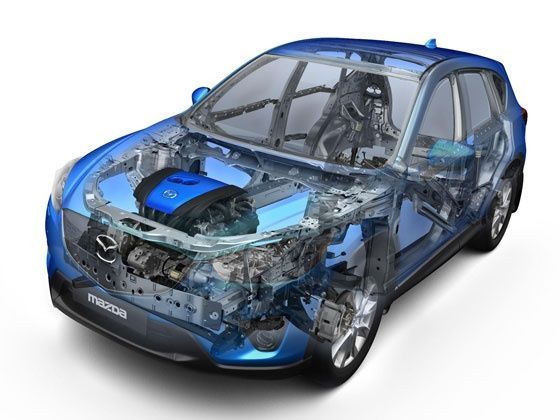Car manufacturers are trying to make fun to drive cars that are environment friendly with technology like variable displacement which targets only one component for environment friendliness. Mazda has taken the game to a whole new level with their SKYACTIV technology. The engine, transmission, chassis and body of a car are all designed under the SKYACTIV technology. Unlike most other manufacturers who treat only their ‘eco’ cars with technology to reduce emissions Mazda have announced that all their models from 2012 onwards will come with their latest SKYACTIV technology. This technology not only reduces emissions of a car but also improves driving dynamics for spirited drivers and enthusiasts.
Mazda’s first car to feature its SKYACTIV technology will be the Mazda CX-5 which will debut in the Frankfurt Motor Show this year. If this technology reduces emissions by 15% for their petrol engines and 20% for diesel engines as claimed, Mazda will leave economy oriented cars and hybrid cars looking a bit embarrassed. Both the SKYACTIV-G petrol engine and the SKYACTIV-D diesel engine are Euro 6 compliant. The all new SKYACTIV engines have a compression ratio of 14:1 which gives the petrol engine a higher compression ratio than that of a Formula 1 engine.
The SKYACTIV technology focuses on three areas - advanced engines with high compression ratio, efficient transmissions and lightweight sophisticated chassis technology.

Mazda’s engineers used a back to basics approach to develop their SKYACTIV technology. Most of the energy from fuel is wasted by a vehicle’s powertrain. This has been addressed by Mazda to increase the efficiency and performance of their next generation engines. Mazda has developed two all new compact and lightweight six speed transmissions, one manual and the other automatic. The automatic transmissions is a dual clutch system combined with benefits of a continuously variable transmission and conventional step automatic transmission, this setup is 7% more efficient and the system has a quick shift pattern aimed at enthusiastic drivers. The manual has been designed to deliver crisp gear changes. The reverse idle shaft has been removed for weight saving and a common second and third input gear is used instead. The gearbox is 3kgs lighter than a normal unit.
No comments:
Post a Comment